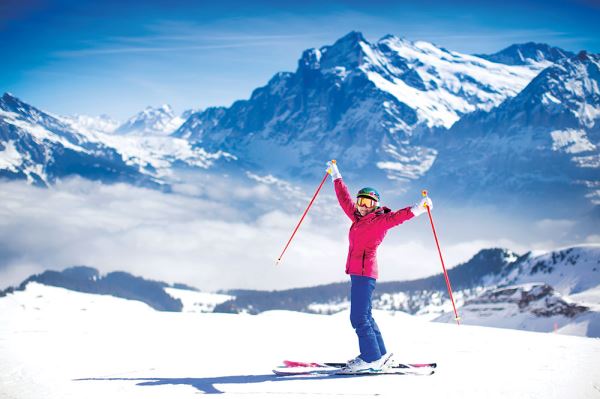
With the summer months in the rearview mirror, you and your family may be getting excited to start hitting the slopes, exercising and enjoying that fresh powder. But, the most important thing you can do, that you might be forgetting, is to always make sure your body is physically fit for those runs.
Being physically prepared will help to reduce your risk of being injured at any point throughout the season and also improve your skiing or snowboarding ability. Continuing to physically prepare your legs will make every time you hit the slopes much more fun, especially so they won’t burn or give out on you too early in the day—making you even more prone to injury.
“Approximately one-third of all ski injuries occur to the knee joint and ligament sprains on the inside of the knee,” says J. Kendall Christensen, DO, a board-certified family medicine and fellowship-trained sports medicine specialist at Bingham Healthcare Orthopedics & Sports Medicine. “Other areas commonly injured are the shoulders, thumbs, and head (which can be prevented by wearing a helmet).”
To avoid many of these injuries, a comprehensive ski season conditioning program should include: cardio exercises, strength training, flexibility work, and balance and agility exercises. Here, Dr. Christensen provides some simple pre-ski training exercises that you can do before you hit the ski slopes to help keep you and your loved ones safe.
Bridge
Suggested: 4 sets of 8
“Hamstring and gluteus strength is critical to prevention of leg and knee injuries,” says Dr. Christensen. “This is a great exercise to improve overall stability of your legs.”
Lay on your back with your knees bent and your feet flat on the floor. Raise your hips off the floor until your body forms a straight line from your shoulders to your knees. Hold that position for 10 seconds then slowly lower your body back to the floor.
Eccentric Leg Press
“It is helpful to train your muscles as close to how they will work in alpine skiing,” says Dr. Christensen. “This exercise prepares you for the downward pressure that accounts for approximately 80% of skiing forces.”
Load the leg press with about 60 to 70% of what you can lift with both legs. With one leg, lower the plate down for six seconds to where your knees make a 90 degree angle (if you have knee problems then you may need to use less weight and not bend your legs as far). When you’re at the bottom, push up with two feet. Make sure to go slowly, and make sure to resist the weight as you come down, being careful that you keep the movement smooth and in control.
Medicine Ball Pump Squat
Suggested: 3 sets of 1 minute each
Your quadriceps muscles are the big muscles that will do most of the work and it is important to make sure they are strong and can last you the day. Performing this exercise will build muscular endurance in the lower back, glutes and quads.
Hug a heavy medicine ball at chest height and lower into a squat position. Make sure to stay low, doing short pump squats (pulsing up and down about an inch or so) without coming back up to start. The muscles of your thighs will be constantly contracting.
Monster Walking
Suggested: 3 Sets of 10 steps in both directions
“This exercise helps to build strength in the lateral hips,” explains Dr. Christensen. “This will assist you to keep your knees apart and decrease the stress on the ligaments of your knees.”
Place a resistance band around your knees so that when your feet are shoulder width apart the band is moderately tight. Squat until the thighs are almost parallel to the ground. Now sidestep without coming out of the squat position and never let your feet come closer together than shoulder width.
Stretching
Stretching can help prevent many musculoskeletal injuries including knee injuries. While general stretching is important there are a few specific groups that will be important to stretch to prepare for skiing.
Hamstrings, quadriceps, adductors and maybe most importantly calves all should be warmed up and stretched. It is important to remember when stretching the calves that in order to hit both your gastrocnemius and your soleus muscles you need to stretch with your leg straight and also with your leg bent. All stretches should be held for a minimum of 30 seconds and remember, pain does not equal gain with stretching.
How to Avoid Skier’s Thumb
Skier’s thumb is a common injury that can cause problems in the future or even lead to surgery. This injury occurs when your thumb hits the ski pole (usually while falling) and gets bent sideways. In order to prevent this you should try to remember to drop your pole as you are falling. Poles that have finger grooves and don’t have straps can help prevent this injury.
To schedule an appointment or consultation, call his office at (208) 535-3626. Se habla Español.
www.BinghamMemorial.org
Click here to read the latest issue of Discover Idaho Falls.